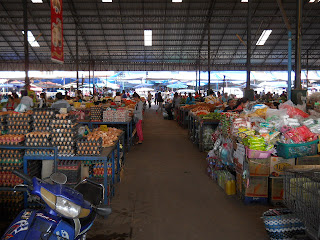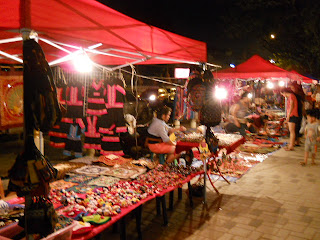 Talat Sao Mall II new annexed building beside the present one was officially opened on the 11.11.11.
Talat Sao Mall II new annexed building beside the present one was officially opened on the 11.11.11.This is a modern shopping complex in Vientiane having frontage facing Lane Xang Avenue.
Fully airconditioned with escalators and lifts covering a eight level building.
A basement for car park was also available.
The owner is Singaporean Dr Lawrence Leow,Chairman and CEO of the Crescendas Group.
In fact the current old building was quite congested and is a very popular shopping area to the locals and tourists.
They called it the morning market and opening hours are from 07:00 till 16:00 hours.
The tenure of this mall is till year 2049 after which the whole building ownership will revert back to the government.
Meanwhile a huge five storey European architecture megamall with construction started on July 2011 and scheduled to be completed in 2013 will transform the city into a more lively and bustling place.
It's the Regal Megamall City to be located in Sikhai Village,Vientiane.There will be nearly 1000 outlets ranging from hypermarkets,boutique,children playground,restaurants to entertainment outlets.Parking bays will be on the highest level.
The price will be from 23.2 million Lao Kips per square metres.
Interested investors may contact the office at km7 Road,No:13 North,Na-Hae Village,Sikhottabong District,Vientiane Lao PDR or fax:021 620 638. Available 70,000 square metres of retail floor.
'The early bird catches the worm'

Textile weaving is traditionally women’s work. Men help with the planting of the mulberry, cotton, and hemp, and with the construction of the looms and spinning wheels, but the work of processing and preparing the yarn, dyeing, designing patterns, and weaving is done almost exclusively by women and girls.
So important are women’s weaving skills in Lao culture that traditional Lao songs, poetry, proverbs, and legends are full of references to them.
Even in the 21st century, a girl’s marriageability in some rural Tai-Lao communities still depends on her weaving skills.
A Tai-Deang bride must prepare a trousseau of her own handwoven silk products: intricately woven and embroidered sinh (skirts), sarongs, silk cushions, silk blankets, cradle cloths, mosquito nets, bed covers, and door curtains.
During the wedding ceremony, the products are publicly displayed and distributed to her husband, in-laws, and relatives.

The Tai-Dam and Tai Phoun weavers of Xieng Khoung in northern Laos are expert silkworm raisers, silk producers, and users of natural dyes.
Since 2005, when Saoban began working with the Tai Dam weavers of Xieng Khoung villages, the Tai-Dam weavers have supplied Saoban with high-quality natural-dyed raw silk used mostly for men’s and women’s clothing.
The Xieng Khoung silks are also popular with Saoban’s Italian buyer who sells custom-made silk clothing and bags under its private label.

The Phuthai weavers of Song Khone District of Savannakhet Province are traditionally cotton producers and cotton weavers.
They grow the native variety of short-fiber cotton and weave the cotton to produce the rough indigo-dyed checkered cloth used as loincloths and sarongs for men, and as headscarves and household linens.
This rough-textured yet comfortable cloth was originally considered a cheap material for poor farming families, but in early 2000 Japanese development workers determined that it had broader potential.
With Japanese assistance, some Phuthai weavers started a business creating and selling natural cotton products under the Laha brand.

The older Tai-Phuan and Tai Deang ethnic groups of Bolikhan District were war refugees from northern Laos; recent settlers had migrated from land-scarce villages in the north to the newly opened lands of Bolikhan District.
Many have established rice farms; silk production provides supple- mental income for women.
The Bolikhan weavers specialize in producing sinh, tinh sinh (skirt borders), tablecloths, and scarves .

A look at the ceremonial dresses.
Lao women wear the silk skirts,blouses and scarves.
Whereas the menfolks wore the sarong,big large pants or the peasant pants.
Costumes of the men rural folks.
Men and women don’t have to wear the traditional Lao costume when they dance the 'lamvong' together at a general party, but women who attend a formal occasion such as a wedding have to wear the traditional “sinh mai” dress.


Wooden weaving handloom equipment.
Silk was introduced to Laos when the Tai-Lao peoples migrated from their ancestral lands in Southern China into present-day Laos, bringing with them the knowledge of silk cultivation, dyeing, and weaving on upright wooden looms.
In Laos they encountered the indigenous Mon-Khmer people, who used back-strap or body-tension looms to weave other types of fabric, mainly from raw cotton and hemp.
This cultural contact and has given Lao textiles the diversity and intricacy of designs that make them stand out today.

Silk yarn in multiple color range.
Natural silk is produced by silkworms that spin fine filaments into cocoons.
It takes 24 days for a silkworm to mature from egg to cocoon.
To extract the silk the cocoons are plunged into pots of boiling water to soften the silk.
Lao silk cultivation,dyeing and weaving is still very popular in central and northern Laos and the ethnic groups like the Tai Dam,Tai Daeng,Tai Moei,and Tai Phuan ethnic groups are keeping the tradition alive.

Saoban (village) weavers are mostly rural girls and women.
A wholesale shop with very well stocked silk weaving equipments,silk yarn,embroidery threads and anything concerning weaving.
Business was thriving in this shop which seemed to be the main supplier in town.
Look at the handloom gadgets stocks,this implied that the cottage industry is very widespread over here in Laos.
Laos owned something very exclusive and rare,the rural population with their expertise in handweaving skills that has been an ancestral tradition.
They are highly skilled knowledgeable artisans.
Laos remains one of the few places in the world where cottage weaving is an important part of everyday subsistence, a necessary and recognized skilled trade.
The cottage industry is predominantly female, with the silk processing skills traditionally handed down from mother to daughter for generations.
In this way, the history of Lao women’s home spinning and weaving of silk goes back thousands of years. Even today, weaving is an important part of many rural Laotian women’s daily life.
Embroidery threads in smaller spool and cone form.

 Buying Lao silk handicrafts and garments will help villagers preserve their ancient tradition.Some of the proceeds also donated to schools in improving education and to further community and cultural de velopment.
Buying Lao silk handicrafts and garments will help villagers preserve their ancient tradition.Some of the proceeds also donated to schools in improving education and to further community and cultural de velopment.Tai-Kadai populations (approximately 66 percent of the population) came into Laos from what is now northern Vietnam, probably originating in southern China, during the last millennium and a half. Tai women brought with them the freestanding frame loom, silkworm cultivation and yarn preparation, and a three-part design for women's sarongs or wrap-around skirts (sinh).
The adoption of Theravada Buddhism by many Tai speakers had a major impact on textile production and meanings.
Theravada Buddhist monks may neither weave nor cook. Thus women's work includes not only the preparation of cloth for secular and ritual purposes but also the provision of textiles to members outside the family.
Tai women provide white cloth to monks, who cut, sew, and dye it for the robes (siiwon) they will wear.
Women's sinh display traditional designs abstracted from the natural and mythological worlds; men wear sarongs with blocked or checked patterns.
The man's sarong is an elegant garment. Woven in plaid two-ply silk heavier than that used in a woman's skirt, or in cotton, it produces a shimmering color.
The man's longer wraparound skirt (yao or hang), with its ends twisted together in front, pulled between the legs, and fixed into the waist band at the small of the back, is the product of many months of labor, with heavy plied silk forming both warp and weft. Utilitarian textiles, such as blankets and shawls, are usually without design, but can be checkered or have subdued patterns.
During the nineteenth century, European travelers recorded that everyday men's clothing was skimpy at best, and women were often bare breasted, wearing drab skirts.
The biang(hom), made of two or more two-meter warp lengths sewn along the selvage, which could be draped around the shoulders to keep warm during chilly nights and mornings, was a major garment well known even in early colonial Cambodia and Saigon. In the early nineteenth century, large quantities of English textiles began appearing in Lao markets.
Lao highland groups (11 percent of the population) include the Hmong, Mien, Lahu, Akha, and Lisu, and their traditional dress is basically the same as in Thailand.
During the war in Indochina in the 1960s and 1970s, the lives of many of these groups were disrupted.
Many Hmong and Mien were resettled internally in camps at lower elevations, and others eventually fled the country as refugees to camps in Thailand and then to third countries.
Ethnic dress was largely exchanged for lowland sarongs, partly due to the hotter climate and partly to disguise identity in a strange environment where their ethnicity might cause problems.
Life in the camps brought more free time, commercial marketing of textiles, and exposure to new designs and styles. Hmong and Mien who fled as refugees to other countries such as the United States and France began ordering traditional clothing from refugee camps in Thailand or from relatives in Laos.
These costume components ordered from abroad were executed in much finer stitches and with more elaboration of appliqué, silver, and other ornamentation than had previously occurred in Laos.















































